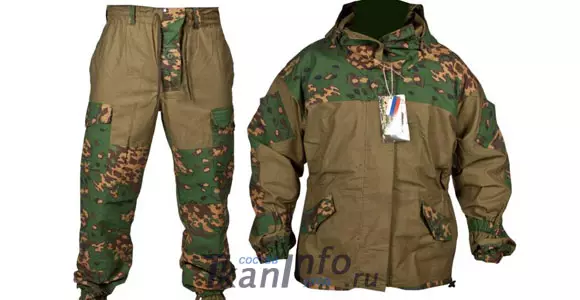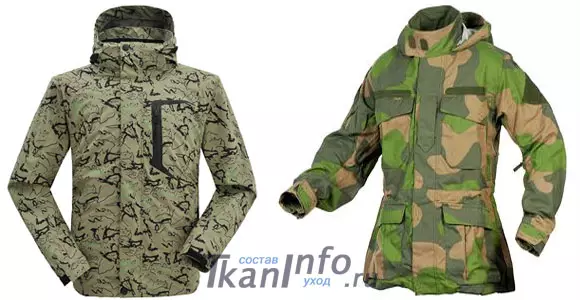The purpose of camouflage clothing is to make a person imperceptible against the background of the environment. Initially, it was a uniform for military, hunters and fishermen. Today, camouflage fabric is used for tailoring jackets, vests, trousers, hats for everyday socks. More such clothes are suitable for men, but among representatives of the beautiful floor there are lover of such dresses. In this article, we will talk about the varieties of camouflated tissue, its properties, the conditions of care for things manufactured from it.

Camouflage fabric
Translation from French The word "camouflage" means "masking". For the first time, the camouflage fabric was manufactured for the British - Warriors of the Anglo-Board War (1899). For soldiers sewed outfitting of a marsh color, which called "Khaki". During the Second World War, the varieties of colors and shades of camouflage fabric were already up to 30, they were widely used by the soldiers of Germany. The Soviet army also quickly took into arms camouflage fabric. One of the most popular and relevant to this day is the uniforms "Birch" in black and white tones. During the Cold War, masking suits made from camouflaged fabric were divided into several species, depending on the pattern on the canvas: "Forest"; "Jungle"; "Desert"; "Bush"; "Winter".Types of camouflage materials in the directions of application
Varieties of coupling cloth for sewing camouflage costumes, they are divided into application directions to groups: Army camouflage, hunting, for fishermen and outdoor clothes.
Army camouflage - textiles for the manufacture of uniforms for the army, power structures, police, security agencies. For this type of uniforms, cotton and blended materials are used with impregnation, the most sought-after from them are: Oxford, casing, fleece.
Article on the topic: Photo frames with their own hands from undergraduate materials: Master class for children
Hunting camouflage may be, depending on the season and terrain, summer and winter. Light textiles is made of cotton fibers, woolen or chemical. For the cold pore of the year, camouflage tissue is released with an additional warm layer. So that the clothes of this type are not wet, the canvas are treated with impregnation. Survived in the production of hunting costumes are weeping fabric, Oxford, fleece, Rib Stop.
In colors Street fabrics for sewing a hunter uniform is divided into such types: Dark forest, Flora, Autumn forest, Snow forest, etc.
The composition of the couch cloth for sewing the uniforms of fishermen is the same as in hunting costumes, only here impregnation makes a thicker layer to increase the water-repellent properties of the material. Oxford, cloak, rib-stop, Greta are those outdoor fabrics that are used in the production of suits of this species. Coloring textile costumes for fishermen - storm, reed.
Camouflage for outdoor activities includes both light clothes (T-shirts, T-shirts, Panama), and warm (jackets, vests, raincoats, overalls, pants). The composition of the fibers for the production of this type of clothing uses more natural cotton or woolen. Fleece, torn matteries are those types of textiles, of which camouflage for outdoor activities is obtained by a pleasant body, soft and warm. Often, such clothes are equipped with reflective elements.
Types of matter in composition and properties
Oxford
This type of textile refers to synthetic or mixtures, they are produced from polyester and nylon. In the manufacture, the weaving "Rohozhod" is used, on the canvas threads form interlacing in the form of squares. Oxford is distinguished by strength and durability, resistant to chemical substances, retains heat well, not blown, waterproof. Textile Oxford is divided into subspecies depending on the thickness of the threads used for its production - from 210 D to 600 D.Article on the topic: How to make a Christmas tree made of fir bumps with your own hands with photos and videos
Oxford is used in the sewing not only clothes, but also other things: tents, backpacks, automotive textiles, shoes.
Oxford textile care: washing in water up to 60 degrees using a washing powder for synthetics. Mode "Manual Wash", "Delicate Wash", spin up to 400 revolutions. Drying in the awesome form, in ironing Oxford does not need.
Rib Stop
This heating tissue is made of cotton fibers and polyetrarmated thread, which is built into the structure of the web every 6-8 mm and forms a "lattice", protecting material, in the case of mechanical damage, from further rupture.
The characteristics of the mixture of Rib-stop are the same as Oxford: low seashell, does not sit down after washing and drying, durable in operation, warm.
Care of the jacket cloth Rib-stop: washing in warm water (40-60 degrees) in the "Synthetic" mode, "manual washing", drying in a ravenment. The use of detergents is recommended for synthetic and natural tissues. Mixed cloth rib stop in ironing does not need.

Greta
Mixed fabric made of cotton and polyester. Weaving the fibers has such a feature: cotton thread is located with the wrong side of the canvas (to the body), the synthetic thread - from the front side. A small-sized heater is characterized by high wear resistance, well warms, absorbs sweat, not blown away.Care of the material Greta: Washing in water no more than 60 degrees, Synthetic mode, "Manual wash", spin - up to 800 revolutions. Dry things that are stitched from this street fabric are recommended in the rave, ironing - from the wrong side in the synthetic mode.
Cloak
This type of heater makes their synthetic fibers - nylon and polyester, or in a combination of synthetic cotton. The cloak can be monophonic and with the lower membrane layer, which makes the canvas warmer. To increase the performance characteristics, this jacket tissue is amenable to treatment with impregnation. The outdoor blade fabric is distinguished by wear resistance, waterproofability, ease of care. From it, in addition to camouflage clothing, sew uniforms for tourists and climbers, tents, shoes, textiles for cars.
Article on the topic: Ladybug from tires do it yourself with video and photos
Care for a cloak cloth: Wash in Synthetic mode, spin - 400-800 revolutions, ironing is not required. Fresh small stains can be simply lined with a sponge dipped in warm water. It is not recommended that the use of chlorine-based stains and bleachs are harmful, they harm the structure of this scholar tissue.
Fleece
In the production of camouflage, a polyfleas fiber is used, consisting of 100% polyester. Woven woven so that air chambers are formed in it. This blended fabric is soft, durable, not pulled out and does not sit down, does not cause allergic reactions. Polyflis is also called synthetic wool for its properties to keep warm and warming the body.Fleece Care: Wash in Synthetic mode, spin up to 800 revolutions. Drying in rave. There is a camouflage tissue of this species with a non-smoking iron, but it does not particularly mind and does not need it in ironing.
Table fabric
Refers to mixtures, made of viscose and polyester. Well erased, absorbs moisture, pleasant to the body, does not cause skin irritation, does not require complex care. A torn camouflaged fabric is used for sewing light clothes: Mains, T-shirts, Panam and Cap.
Care of grip textiles: washing in water up to 70 degrees, "Cotton" mode, "Synthetic", spin up to 1000 revolutions. Ironing in "Cotton" mode, "Synthetic". The detergent is recommended as detergents for synthetics.
